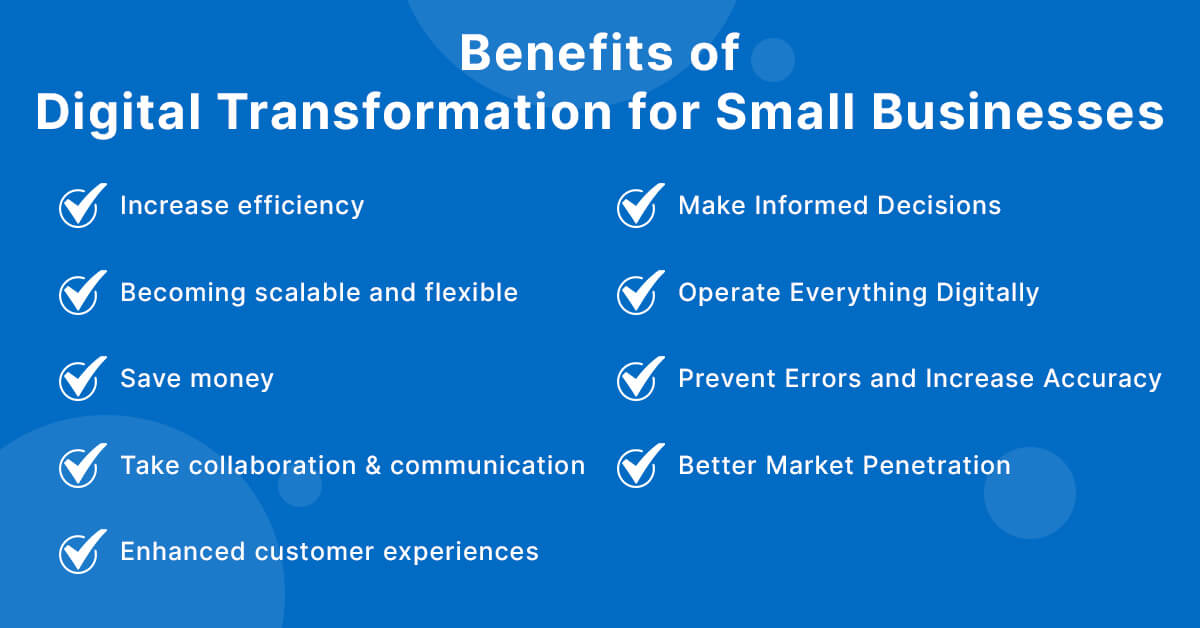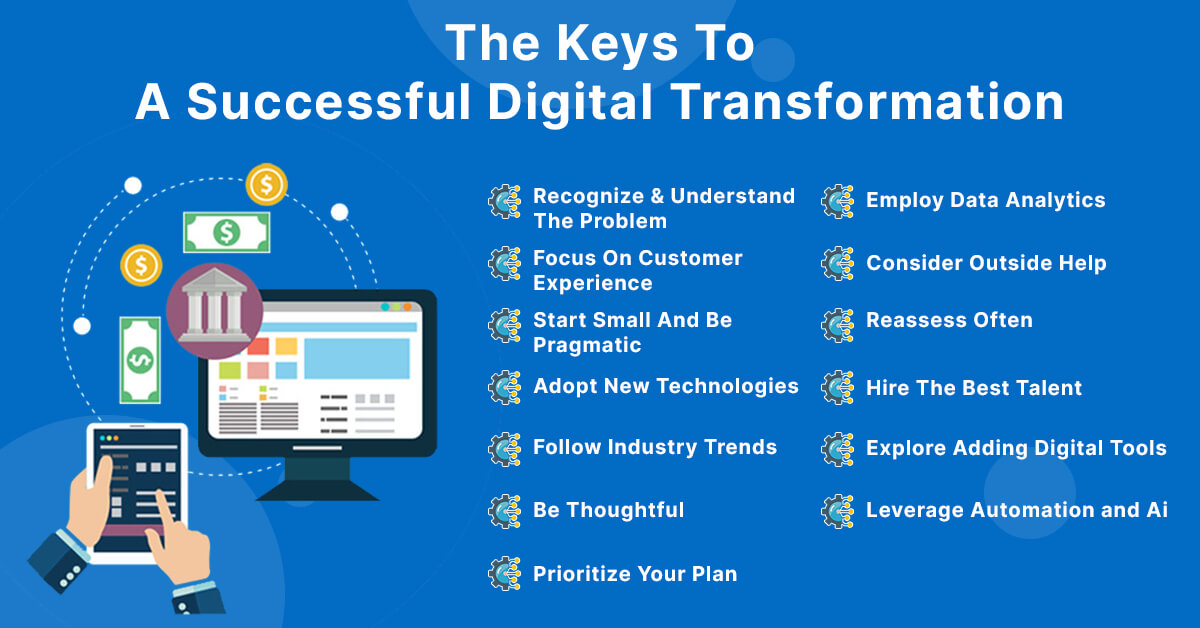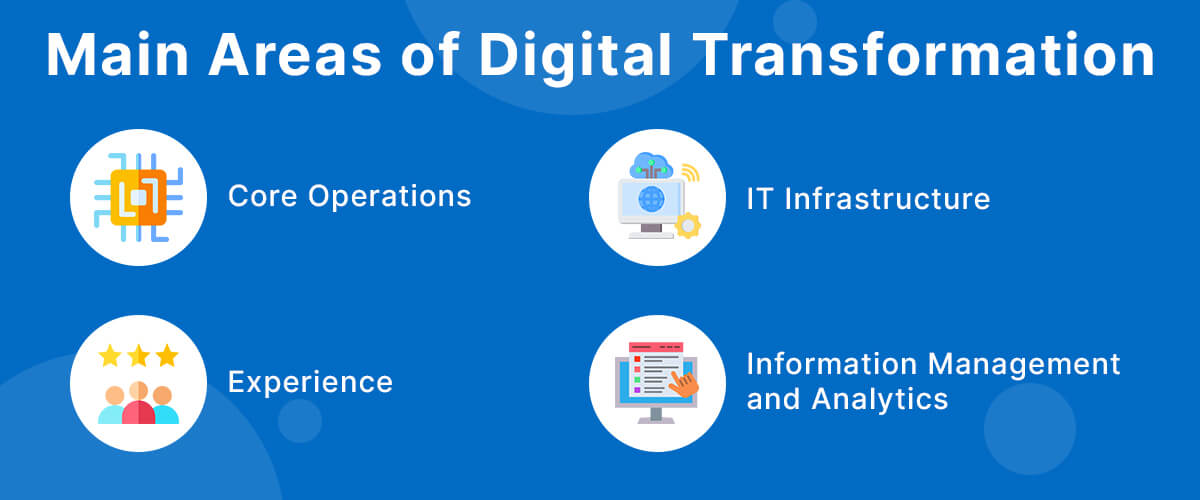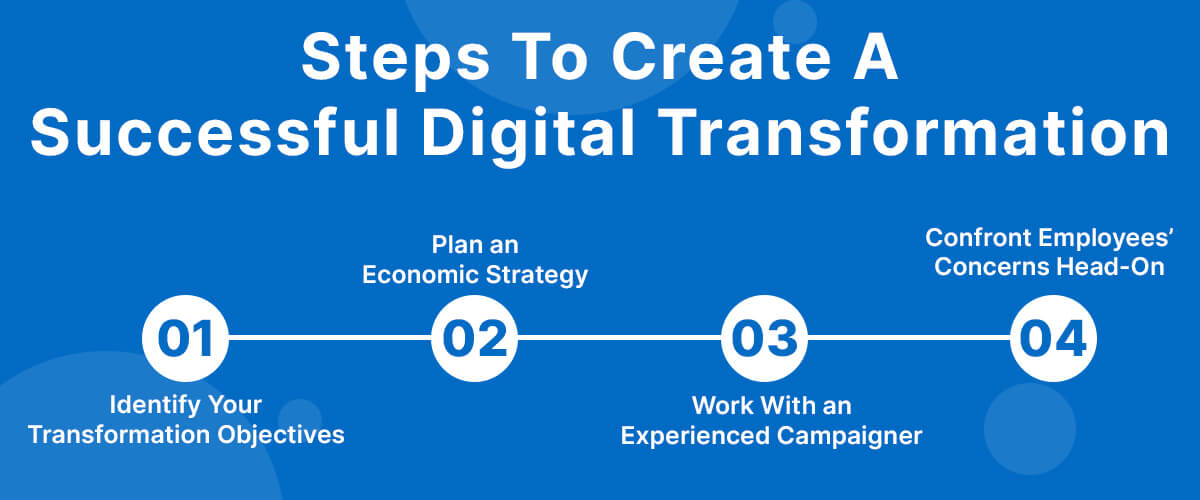
According to research, worldwide spending on Digital Transformation technologies is to reach a phenomenal $2.3 trillion by 2023. It points out the fact that enterprises are increasingly viewing Digital Transformation as a long-term investment option. When enterprises all over the world are planning to spend so much on Digital Transformation, then as a small business owner, you just cannot afford to sit on the sidelines.
Many small business owners are apprehensive about Digital Transformation. They think that Digitalization is not for them. On the contrary, Digital Transformation helps small business owners take on their bigger competitors head-on. It helps them level the playing field to a large extent through the innovative application of digital technologies.
Table of Contents
- What is Digital Transformation?
- Why do Small Businesses Need to Invest in Digital Transformation
- Digital Transformation Best Practices
- Recognize and understand the problem you are aiming to solve
- Focus on customer experience.
- Start small and be pragmatic.
- Adopt New Technologies
- Follow Industry Trends
- Be Thoughtful
- Prioritize Your Plan
- Employ Data Analytics
- Consider Outside Help
- Reassess Often
- Hire the Best Talent
- Explore Adding Digital Tools
- Leverage Automation and AI
- Digital Transformation Technologies and Services
- What are the four main areas of digital transformation?
- Steps for an Effective Digital Transformation
What is Digital Transformation?
Digital Transformation is a term that is being tossed around quite frequently in the digital world. But very few people actually understand it perfectly. Everyone has their own set of beliefs and understanding which makes it less efficient in implementation.
Contrary to popular belief, Digital Transformation is not just limited to building software, a website, or a mobile app. Many people think that the job of Digitalization is complete when they build decent software, a website, or a mobile app. Digital Transformation is the process of taking a completely new approach regarding a traditional offline business.
In Digital Transformation, we are concerned with the integration of digital technology in all the major areas of a business. The idea is to align the business with the needs of the digital customer so that the business can deliver value to the customer in the most efficient manner.
Digital Transformation is more of a cultural change that challenges the traditional status quo of doing business.
Why do Small Businesses Need to Invest in Digital Transformation
Now the question arises why, as a small business owner, you should opt for Digital Transformation. Let’s have a look at some of the top reasons that will help you to make the decision to transform your business to digital.
Increase efficiency
Businesses leveraging digital tools and platforms will avail of real-time data access, analysis, and decision-making, leading to faster and more informed actions. Besides, routine tasks and processes’ automation enhances operations, reducing manual errors and enhancing productivity. Also, employees are engaged in productive tasks rather than tedious, repetitive tasks, which improves employees’ efficiency and, thus, productivity.
Becoming scalable and flexible
Small businesses must quickly adapt to changing business requirements and dynamics to sustain and thrive. That’s where cloud-based solutions offer scalability to small businesses to accommodate growing data and user demands.
Save money
Digital technologies can reduce the environmental impact by optimizing resource usage and reducing paper waste, saving money. Plus, streamlining processes and automating tasks can lead to significant cost savings. Cloud computing and SaaS (Software as a Service) models often reduce IT infrastructure and maintenance costs. It makes digital transformation a cost-effective option as opposed to traditional models.
Take collaboration and communication to the next level
Most Cloud-based platforms enable real-time sharing of documents and data with video conferencing or project management solutions. Digital tools facilitate collaboration among teams and partners, regardless of geographical location.
Enhanced customer experiences
Customers are important assets for businesses that they cannot afford to lose. Customers look for services that are easily accessible and with great convenience; that’s where multichannel communication options help. Digital transformation allows small businesses to personalize customer interactions, providing tailored services, recommendations, and support.
Make Informed Decisions Using Data-Driven Insights
Gone are the days when you needed to rely on your intuition to make business decisions. Using Big data analytics now, you can inculcate the process of data-driven decision-making into your small business. Data helps you in validating a particular course of action in your business before you commit to it.
Data-driven decision-making can be used to:
- Identify the requirements of customers by analyzing their response to the products and services of the business organization.
- Find out potential issues in a particular product or service and also identify possible solutions.
- Test the market for a new product or service.
Data-driven decision-making is for businesses of all shapes and sizes. Earlier, only enterprise-level organizations had access to sophisticated algorithms that could derive insights from data produced by these organizations. But with the rise in the number of smartphones and other smart devices such as IoT sensors, the amount of data produced by humanity broke all previous records.
With the rise in the level of data produced, data analytics started becoming more affordable for small businesses. Today any small business can access the treasure trove of data produced by it and gain meaningful insights from it at a substantially lower cost. Lower costs make a case for SMB Digital Transformation more robust.
Operate Everything Digitally
Digital Transformation allows a business to operate digitally. Are Banks closed for the day? Don’t worry; you can accept or give payment through digital means which are working 24×7. Employees cannot come to the office for some reason. Let them work from home (WFH).
By transforming your business processes to digital, your business, be it small or medium size, can automate tasks like employee management, production management, Purchase, supply chain and logistics management. By automating these daily tasks, you will be able to focus on strategic future planning for your business.
The leading web development companies can build the best business solutions based on your requirements.
Digitization can help you in operating your business remotely with little human intervention, thus improving the efficiency of your business exponentially.
Prevent Errors and Increase Accuracy
Suppose you are planning to launch a new product in the market, which one of these statements inspires more confidence?
“I have a gut feeling that the color of this product should be yellow, people love the yellow color.”
Or
“Data shows that the yellow variant of our competitor’s product has received a good response from the market; sales have improved by 33%.”
If I were an analytical businessperson, then definitely the second statement would inspire more confidence in me.
That is the beauty of data, it inspires confidence, and you do not have to remain dependent on your “gut” feeling anymore.
With data backing your decision, you will be able to decide in a much more confident manner. Whether the decision is regarding launching a new app or product, changing the look and feel of your website or app or anything else, with data driving your choices, the propensity of your choices proving correct will improve dramatically.
By increasing the accuracy of your decision-making process, data analytics helps to propel your business in the right direction without worrying about the preciseness of the decision.
Data is more reliable than your instincts because it is concrete, a characteristic that your gut feeling just does not possess. To instill confidence in decision-making, removal of subjective elements from your business decisions is necessary. Data analytics achieves this purpose for you.
Understand that the data must be accurate for data analytics to be correct. If the data collection process is inherently flawed, then you cannot expect great results.
Better Market Penetration
New customers are the lifeline of any business. Transforming your business processes to digital is an initial step in helping the business reach greater heights. Digital Transformation tools are revolutionizing the way we do business, and they can aid you in gaining access to new customers in different geographies.
There is a huge amount of data available to businesses and making sense of the huge chunk of data will ensure that big data plays a vital role in business success. Through Digital Transformation, your business will not only penetrate previously unexplored markets but also find new customers within your existing market.
When you are planning to introduce new products into a particular market, then accurate market segmentation is vital for better market penetration. Digital Transformation can help you in correct market segmentation, thus allowing you to target your product/service to the right customers. It can help in improving your customer conversion rate manifolds, helping you build a loyal customer base.
Digital Transformation Best Practices
Digital transformation requires a well-managed approach. Following the best practices allows businesses to accelerate digital transformation initiatives from the get-go. Here are the practices to consider when transforming your business digitally.
Recognize and understand the problem you are aiming to solve
Recognizing the digital transformational objective and understanding the challenges that it solves is important knowing beforehand. It helps in creating a roadmap for digital transformation and making data-driven decisions relevant to tools and processes leverage. Also, businesses can quickly and easily achieve digitalization when they have all the required data analysis.
Focus on customer experience.
Customer experiences led small businesses to drive digital transformation and invest time, resources, and efforts in taking out digital initiatives. For instance, customers stay happy when the business supports multichannel access wherein the activity started on one device is completed on another device hassle-free. Focusing on this minimum customer requirement allows businesses to tailor digital strategy accordingly.
Start small and be pragmatic.
Businesses should not create digital transformation strategy in conjunction with technologies that require them to break the bank. Instead, start with small, learn as the business progresses, and then enhance digital strategy gradually. Most of the digital channels are scalable which helps test which channel is best suited for them before delving deeper.
Adopt New Technologies
Large enterprises are already playing with innovative technologies such as AI, IoT, AR/VR, etc.. the small business can begin with simple software and a small strategy, which is enhanced later. This approach to adopting technology helps businesses stay relevant and ahead in the digital race.
Follow Industry Trends
Make sure digital transformation is not a destination but it’s a never-ending journey that goes on with technology enhancements. Stay abreast of the latest technologies and tools in niche industry to ensure digital transformation step in with the market trends and evolving user preferences.
Be Thoughtful
When small businesses get ready to drive digital transformation, they must assess what needs to be changed under the digital strategy while analyzing gaps. Involving every employee in the assessment using assessment tools would help in knowing the current level of digitalization along with areas of improvement compared with competitors’ digital strategies.
The valuable insights are worth figuring out the best digital solution with essential components, ultimately increasing productivity. Before proposing a digital agenda to employees, showcase the value digital transformation drives, such as underlying costs, ROI, additional benefits, and other gains.
Prioritize Your Plan
The assessment process reveals the problems that business is facing in the absence of digital strategy and how technology leverage fixes them. For instance, businesses consider AI-powered chatbots to improve customer support, which customers expect most. Prioritize digital changes to be incorporated sequentially, and their impact is assessed.
Employ Data Analytics
Data analytics helps connect the dots and compute insights from the diverse set of data, which helps in data-driven decision-making. Data analytics help small businesses get the data collected and computed from websites, social channels, email, and others. In addition to data analysis, small businesses learn about various aspects of the customer journey, such as devices used for shopping, how users reach out to the business, and more. The rich insights enable businesses to approach the users uniquely, maximizing conversion.
Consider Outside Help
Despite having digital tools, key stakeholders require investing a lot of time in understanding users’ digital journey and filling the void. If it overwhelms you, consider taking outside help from a digital marketing agency who reviews the data and tools to determine how digitalization is going and what needs improvement. Their expertise and experience help businesses to increase their brand value and ROI.
Reassess Often
Your digital transformation objective perhaps brings a good return in the present time. Still, you cannot ensure the benefits in the long run if the digitalization strategy is not reassessed and improved. Adopting new technologies to deliver the best experiences and cement user loyalty is important, wherein re-evaluation of digital transformation at regular intervals is a prerequisite. Check out how the employees and users feel about the change, what’s working well, and what can be done better.
Hire the Best Talent
The right team can make or break the project’s success. If you want to succeed in the digital transformation of your business, screen the talent optimally before hiring. You can hire in-house employees or remote developers because the availability of digital tools won’t affect the project at all. Follow the best practices to hire talent for the best results.
Explore Adding Digital Tools
With technological progress, many digital tools are available to roll out organizational transformation. Some tools misguide the businesses and won’t grow. If such tools are not researched well before adopting them, it will be disastrous for business. So, businesses should invest enough time digging through the details of preferred digital tools. It helps them know how they meet current needs and make business future-proof with adaptability to changing needs.
Leverage Automation and AI
When small businesses plan for a digital transformation, the priorities and operations that need to be automated are determined. Here, leveraging AI technology and automation helps in getting things done judiciously.
Digital Transformation Technologies and Services
Digital transformation encompasses various technologies and services to integrate digital capabilities into small businesses’ operations and strategies according to their goals and objectives. Successful digital transformation often involves integrating multiple technologies and services to drive innovation, efficiency, and competitiveness. It includes cloud computing, data analytics, AI, IoT, and more. Take a look at which of them strengthen digital initiatives.
Digital experience platform
A better understanding of the digital customer experience is all-important to deliver the right content at the right time across the right channel or device. That’s where the digital experience platform helps by providing digital marketing, content management, and commerce solutions under the hood. Omnichannel data capture, marketing automation, and real-time personalization help plan and roll out the digital transformation at scale.
Experience commerce
Experience commerce, often called “e-commerce,” involves buying and selling goods and services through digital channels. It encompasses online marketplaces, websites, mobile apps, and various online commerce solutions that enable delivering personalized shopping experiences.
Content hub
A content hub is a centralized platform or repository where SMBs can manage, organize, and distribute content effectively. It is a central point for content creation, storage, and distribution across multiple channels. For digital transformation initiative, the content hub act as an integrated repository for digital asset management, product content management, marketing resource management, and others, making it easier for the digital marketing team to collaborate on content creation and management.
Cloud solutions
Cloud solutions encompass a variety of cloud-based services, including Infrastructure as a Service (IaaS), Platform as a Service (PaaS), and Software as a Service (SaaS). Cloud computing provides scalable and cost-effective solutions to harness the power of digital marketing. The strategy is executed quickly at reduced TCO by leveraging the right mix of marketing tools and cloud infrastructure.
Services, solutions, and consulting
This category typically includes a wide array of services, solutions, and consulting offerings related to digital transformation. It encompasses consulting firms, technology service providers, and solution providers that help businesses plan, implement, and optimize digital initiatives.
What are the four main areas of digital transformation?
Digital transformation typically encompasses “four pillars” that represent the core aspects of an organization’s operations and strategy that are impacted by digital technologies. The four main areas of digital transformation that aligned closely are
Core operations
This area encompasses transforming an organization’s fundamental business processes, operations, and workflows. It involves using digital technologies to streamline, automate, and optimize day-to-day operations such as process automation, supply chain optimization, inventory management, and workforce management. The goal is to improve efficiency, reduce costs, and enhance productivity.
Experience
The “Experience” dimension of digital transformation emphasizes enhancing the customer experience (CX) and sometimes the employee experience (EX). It uses digital tools and technologies to create seamless, personalized, and engaging interactions. For example, developing user-friendly websites and mobile apps, implementing chatbots for customer support, personalizing marketing efforts, and improving online shopping experiences. The employee experience might involve digital tools for remote work, collaboration, and training.
IT Infrastructure
Digital transformation often requires upgrading or modernizing the businesses’ IT infrastructure. It includes hardware, software, networks, and cloud-based solutions. Small businesses can migrate to the cloud, adopt a microservices architecture, or implement DevOps practices to ensure their IT infrastructure is agile, scalable, and responsive to changing needs.
Information management and analytics
Effective data management and analytics are critical in digital transformation. It involves collecting, storing, analyzing, and deriving insights from data to support data-driven decision-making. Big Data platforms, AI and machine learning models for predictive analytics, and advanced data visualization are implemented to drive innovation and gain a competitive edge.
Steps for an Effective Digital Transformation
So you are all excited about leveraging the benefits of Digital Transformation for your business? Then let’s delve into the steps required to complete the process of moving to a digital business effectively.
Identify your Transformation objectives
The first step towards your Digital Transformation process will always entail identifying your transformation objectives. Understand that through Digital Transformation, we are seeking to address specific challenges. Hence the nature and extent of these challenges must be specified in clear terms.
You might need to evaluate all the policies, workflows, and work practices of your business first and see whether they are aligned with the digital way of work or not.
By having clear objectives, you will be able to finish your goal of achieving the digitalization of your business quickly.
Plan an economic strategy
A grave mistake that small businesses make while selecting a Digital Transformation strategy is that they bust the bank in going for bleeding-edge Digital Transformation technologies.
You don’t need to spend serious money on availing of that ground-breaking innovation in digital technology. Remember, you are a small business owner, and hence you need to be wise with your investments. There is no harm in going for cheaper options if they serve your purpose well.
First, identify whether Digital Transformation will help you in making the existing processes of your business cheaper or not. By using simple tools like predictive analytics before spending on advertising, you can test the waters of digitalization before delving deeper.
A similar device is CRM (Customer Relationship Management) software, which is cost-effective and small business owners can easily take its advantage.
Work with an experienced campaigner
Some professionals can help you with the process of Digital Transformation. Such Top IT outsourcing companies will aid you in making the procedure easier.
Find a technology partner that has experience in helping small businesses in making the process of moving to a digital business.
It will not only speed up the process considerably but also take a lot of cognitive load from your mind. Understand that you are an expert in your business and not a Digital Transformation expert.
By outsourcing your Digital Transformation project to a competent IT service provider, you will be able to smoothen the process considerably.
Discuss with your potential technology partners about your requirements and create an effective strategy for your business’ digital transformation that will aid you in your journey.
Confront employees’ concerns head-on
Digital Transformation is a change, and any change faces some resistance as humans by nature are resistant to change. To make your Digital Transformation strategy work, you must take your employees into confidence. Discuss with your employees upfront about the reasons why the business is making use of digital technologies to change a business model.
Usually, employees fear that the digital transformation of business digitally will be difficult for them, or they might lose their jobs. Win their trust by explaining to them the benefits of Digital Transformation in their daily work and show them how it will help them increase their productivity.
Ensure that your employees are sufficiently trained so that they can adapt without any problem.
Future is Digital
There is no business small for Digital Transformation, and small business owners are an industry group that can benefit more by adopting digitalization. Understand that you will be swimming against the tide if you choose to ignore transforming your business for digital. Because the future is digital and you do not want to be an analog player in a digital world.
By taking the help of Digital Transformation specialists, you can quickly achieve your goal of digitally transforming your company, making it future-ready.
 Gillian Harper
| Sep 15, 2023
Gillian Harper
| Sep 15, 2023
A professionally engaged blogger, an entertainer, dancer, tech critic, movie buff and a quick learner with an impressive personality! I work as a Senior Process Specialist at Topdevelopers.co as I can readily solve business problems by analyzing the overall process. I’m also good at building a better rapport with people!






